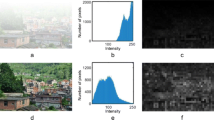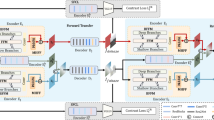Abstract
In scene dehazing problem, single image haze prediction is one of the most challenging issues. In this paper, we propose a hybrid features learning model (HFLM) for haze prediction. HFLM takes a hazy image as the input, and outputs its medium transmission map that is subsequently used to recover a haze-free image via atmospheric scattering model. There are two main stages in HFLM. The first stage is used to extract haze-related features from haze images. The second stage aims to establish the mapping relationship between features and medium transmission. In the experimental part, we explore the hyper-parameters in support vector and verify the significance of the features selection. Further, we compare our method with other dehazing methods and make a qualitative comparison on synthetic images. Demonstrate our method has more superior performance than the state-of-the-art dehazing methods.








Similar content being viewed by others
References
Tang, K., Yang, J., Wang, J.: Investigating haze-relevant features in a learning framework for image dehazing. In: Computer Vision and Pattern Recognition, pp. 2995–3002 (2014)
Cai, B., Xu, X., Jia, D., Qing, K.C., Tao, D.: Dehazenet: an end-to-end system for single image haze removal. IEEE Trans. Image Process. 25(11), 5187–5198 (2016)
Fattal, R.: Dehazing using color-lines. ACM Trans. Gr. (TOG) 34(1), 13 (2014)
He, K., Sun, J., Tang, X.: Single image haze removal using dark channel prior. IEEE Trans. Pattern Anal. Mach. Intell. 33(12), 2341–2353 (2011)
Gibson, K.B., Vo, D.T., Nguyen, T.: An investigation of dehazing effects on image and video coding. IEEE Trans. Image Process. 21(2), 662–673 (2012)
Xie, C.H., Qiao, W.W., Liu, Z.: Single image dehazing using kernel regression model and dark channel prior. Signal Image Video Process. 11, 1–8 (2016)
Meng, G., Wang, Y., Duan, J., Xiang, S., Pan, C.: Efficient image dehazing with boundary constraint and contextual regularization. In: Proceedings of the IEEE International Conference on Computer Vision, pp. 617–624 (2013)
Shi, L., Yang, L., Cui, X., Gai, Z., Chu, S., Shi, J.: Image dehazing using dark channel prior and the corrected transmission map. In: International Conference on Control, Automation and Robotics (2016)
Chen, B.H., Huang, S.C.: An advanced visibility restoration algorithm for single hazy images. ACM Trans. Multimed. Comput. Commun. Appl. (TOMM) 11(4), 53 (2015)
Tan, R.T.: Visibility in bad weather from a single image. In: Computer Vision and Pattern Recognition (IEEE), pp. 1–8 (2008)
Chen, B.H., Huang, S.C., Ye, J.H.: Hazy image restoration by bi-histogram modification. ACM Trans. Intell. Syst. Technol. (TIST) 6(4), 50 (2015)
Choi, L.K., You, J., Bovik, A.C.: Referenceless prediction of perceptual fog density and perceptual image defogging. IEEE Trans. Image Process. (IEEE) 24(11), 3888–3901 (2015)
Li, Y., Tan, R., Brown, M.S.: Nighttime haze removal with glow and multiple light colors. In: Proceedings of the IEEE International Conference on Computer Vision, pp. 226–234 (2015)
Li, Z., Tan, P., Tan, R., Zou, D., Zhou, S.Z., Cheong, L.F.: Simultaneous video defogging and stereo reconstruction. In: IEEE Conference on Computer Vision and Pattern Recognition (CVPR), pp. 4988–4997 (2015)
Alaei, A., Raveaux, R., Conte, D.: Image quality assessment based on regions of interest. Signal Image Video Process. 11, 1–8 (2016)
Zhu, Q., Mai, J., Shao, L.: A fast single image haze removal algorithm using color attenuation prior. IEEE Trans. Image Process. 24(11), 3522–3533 (2016)
Berman, D., treibitz, T., Avidan, S.: Non-local image dehazing. In: The IEEE Conference on Computer Vision and Pattern Recognition (CVPR) (2016)
Langari, B., Vaseghi, S., Prochazka, A., Vaziri, B., Aria, F.T.: Edge-guided image gap interpolation using multi-scale transformation. IEEE Trans. Image Process. 25(9), 4394–4405 (2016)
Kavalcov, L., Skaba, R., Kyncl, M., Rouskov, B., Prochzka, A.: The diagnostic value of MRI fistulogram and MRI distal colostogram in patients with anorectal malformations. J. Pediatr. Surg. 48(8), 1806–1809 (2013)
Ren, W., Liu, S., Zhang, H., Pan, J., Cao, X., Yang, M.H.: Single image dehazing via multi-scale convolutional neural networks. In: European Conference on Computer Vision, pp. 154–169 (2016)
Anzai, Y.: Pattern Recognition and Machine Learning. Elsevier, Amsterdam (2012)
McCartney, E.J.: Optics of the Atmosphere: Scattering by Molecules and Particles, p. 421. Wiley, New York (1976)
Sulami, M., Glatzer, I., Fattal, R., Werman, M.: Automatic recovery of the atmospheric light in hazy images. In: International Conference on Computational Photography (ICCP), pp. 1–11 (2014)
Tarel, J.P., Hautiere, N.: Fast visibility restoration from a single color or gray level image. In: International Conference on Computer Vision, pp. 2201–2208 (2009)
Tarel, J.P., Hautiere, N., Cord, A., Gruyer, D., Halmaoui, H.: Improved visibility of road scene images under heterogeneous fog. In: Intelligent Vehicles Symposium (IV), pp. 478–485 (2010)
Cai, B., Xu, X., Jia, K., Qing, C., Tao, D.: Dehazenet: an end-to-end system for single image haze removal. Preprint arXiv:1601.07661 (2016)
Acknowledgements
This work is supported by the National Natural Science Foundation of China (61502541, 61502546, 61772140), the Natural Science Foundation of Guangdong Province (2016A030310202), the Fundamental Research Funds for the Central Universities (Sun Yat-sen University, 16lgpy39), and the Science and Technology Planning Project of Guangdong Province (2015B010129008).
Author information
Authors and Affiliations
Corresponding author
Rights and permissions
About this article
Cite this article
Yan, J., Liang, X., Lin, M. et al. A hybrid features learning model for single image haze prediction. SIViP 12, 1001–1008 (2018). https://doi.org/10.1007/s11760-018-1245-5
Received:
Revised:
Accepted:
Published:
Issue Date:
DOI: https://doi.org/10.1007/s11760-018-1245-5




